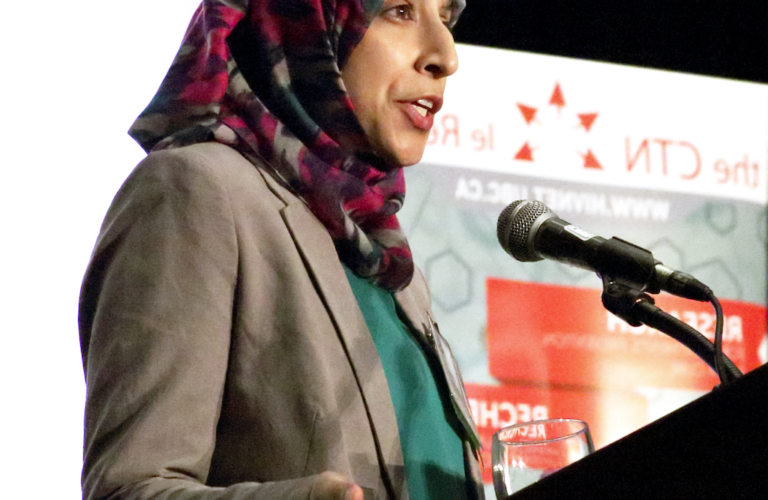In 2020, there were five infants who acquired HIV in Canada at or around the time of birth (perinatally). While the absolute number of perinatal infections remains relatively low, it represents the highest reported rate in Canada in the past five years, and may have been associated with difficulties accessing or delivering health services at the beginning of the COVID-19 pandemic. Thankfully, this trend did not continue into 2021, with only two infants acquiring HIV, signalling a potential adaptation by the health system and by women living with HIV during the pandemic.
This official surveillance data, and the interpretation and contextualization of the results, is one of the main outputs of the Canadian Pediatric and Perinatal HIV/AIDS Research Group. Better known as CPARG, it was started over 30 years ago by Dr. Susan King (Hospital for Sick Children) in Toronto and Dr. Jack Forbes (BC Children’s Hospital) in Vancouver along with other leaders in the field, including Dr. Normand Lapointe (Hôpital Ste-Justine) in Montreal and Dr. Stan Read (Hospital for Sick Children). The group is supported by CTN National Centre data management and statistics staff and is currently chaired by Clinical Care and Management Core Co-lead Dr. Jason Brophy.
CPARG is a group of clinicians and researchers that form the primary resource for pediatric HIV in Canada, through educational initiatives, research projects, and creation of best practice guidelines. “CPARG serves as venue for discussion about pediatric and perinatal HIV issues,” explained Dr. Brophy, Medical Director for the HIV Clinic at Children’s Hospital of Eastern Ontario (CHEO) and an Associate Professor at the University of Ottawa.
“One of our main outputs has been the Canadian Perinatal HIV Surveillance Program (CPHSP), which is funded by the Public Health Agency of Canada, and which tracks HIV-affected pregnancies in Canada,” he said. “It’s also been going on for over 30 years and is one of the longest standing perinatal HIV surveillance projects in the world.”
The CPHSP collects information about infants born to people living with HIV, including antiretroviral therapy (ART) use during pregnancy and infant outcomes, as well as annual updates on those children who have acquired HIV. Co-led by CTN Investigators Dr. Laura Sauvé (BC Children’s Hospital) and Dr. Ari Bitnun (Hospital for Sick Children), the CPHSP has continuously adapted to the changing needs of people living with HIV and their clinicians, all while ensuring patient privacy.

Surveillance data collection: A fine balance
All public health surveillance programs have to balance the depth and detail of the data collected with the need to protect patient privacy. The area of perinatal HIV transmission can be particularly sensitive, requiring an extra layer of consideration to protect families and their babies.
“We take great caution to collect only the bare minimum of information, to avoid the risk of identifying anyone,” said Dr. Brophy. “It can be challenging when there’s only a small number of pregnant people living with HIV in a given province and then there is a perinatal transmission.”
There are limitations to the CPHSP, however, in that it does not collect information on pregnancy losses, miscarriages, or stillbirths, despite them being very important to patients, clinicians, and researchers.
“The CPHSP is very much focused on babies,” said Dr. Brophy. “We can’t collect specific data on pregnancies unless there is a live birth of an infant, even though understanding negative pregnancy outcomes like losses is something that we’re all very interested in.”
However, for pregnancies with a live birth in one of the 22 participating centres across the country, the team is able to collect broad information, including the total number who are engaged in care, on treatment, and virally supressed.
“Even with no HIV treatment or preventive interventions, transmission of HIV happens in only approximately one in four cases,” explained Dr. Brophy. “Getting pregnant people living with HIV diagnosed, on treatment and undetectable is the goal. When that doesn’t happen, then collecting information about both the transmission cases as well as the near misses allows us to provide insight into what might be causing changes in rates of transmission.”
For the period of 1997–2016, a CPHSP publication showed that transmission occurred in 28.9 per cent of cases for pregnant people not on ART, 4.3 per cent for people on ART for less than four weeks, and 0.2 per cent for those on ART more than four weeks.

Dr. Laura Sauvé presenting at AIDS 2022
In their abstract at AIDS 2022, presented by Dr. Sauvé and describing the jump in transmission rates during the COVID-19 pandemic, the researchers also highlighted that there was a corresponding increase in pregnant people living with HIV who were receiving suboptimal treatment. This finding signalled this group as an important current priority for the Canadian health system.
Dr. Brophy also explains how the surveillance program goes to great lengths to avoid stigmatizing or marginalizing people and their families dealing with HIV during and after pregnancy.
“There is a lot of stigma in this area; for example, for pregnant people newly arriving in Canada, those who inject drugs, or women not engaged in care. We don’t want to contribute to stigmatization, but we also want to address the problems that are leading to infant transmission,” said Dr. Brophy. “We want to make sure that people understand this is still a problem, and one that can be solved.”
The researchers also want to avoid causing a panic in communities and policy circles. “We only have about 250 births per year to women living with HIV in Canada; small changes in those numbers lead to larger percentages and look very worrying,” explained Dr. Brophy.
Once the data are collected and reported to the Public Health Agency of Canada for their HIV surveillance reports, the surveillance team and the broader CPARG group use their expertise to further interpret and share the data collected each year and advocate for changes to improve perinatal prevention efforts across the country.
Putting data into action
“CPARG has good relationships with other bodies that provide guidance in Canada. We have liaison members in the Canadian Pediatric Society Infectious Disease & Immunization Subcommittee and the Society of Obstetricians and Gynecologists of Canada (SOGC) Infectious Disease Committee. We’ve also been asked to weigh in on topics by NACI for immunization guidance around children with HIV,” said Dr. Brophy.
CPARG members are also involved with work on the U.S. Department of Health and Human Services (DHHS) HIV Guidelines Committees, including the Pediatric Treatment Guidelines Panel and the Perinatal Treatment Panel. While each country and region have their own HIV-related guidelines, many people around the world see the US guidelines as a main resource for HIV management, explains Dr. Brophy.
At home, CPARG members are leading the development of Canadian guidelines. CTN Investigator Dr. Sarah Khan, whose work in this area began during her CTN Postdoctoral Fellowship, led the development of guidelines on infant feeding for women living with HIV. Additionally, Drs. Bitnun and Sauvé are currently developing CPARG-endorsed Canadian Pediatric Society (CPS) guidelines on the management of infants born to people with little or no prenatal care, and guidance for general pediatricians caring for infants born to people living with HIV.
“As clinicians, we have to make clinical judgements, but having guidance from normative bodies like CPS, SOGC, or CPARG is more likely to lead to practice change and better management of these situations,” said Dr. Brophy. “We also liaise with local clinicians to ensure we learn from transmission cases and try to provide more support to clinicians where it could be needed.”
Research to improve care
Clinical judgement and guidelines require evidence in order to evolve and improve, something that CPARG provides from a wide range of research projects.
Members of CPARG participated in the first trials of Zidovudine for prevention of parent-to-child HIV transmission, and later in studies of ART in children. Now 30 years on, the group continues to be active in the next phase of HIV research, including understanding the implications of HIV and ART exposure and investigating HIV viral remission in children.
“Management of these infants is challenging. It’s also hard to do research with them prospectively, which would be the ideal way to inform their care,” said Dr. Brophy. “Often we do retrospective analyses to understand what factors can lead to higher risk of infant transmissions.”
The most recent study of this type, published in early 2023, analyzed data from the CPHSP from 1990–2020 to identify any associations between ART use among pregnant people and risk of preterm delivery or low birthweight. The team found that ART initiation before conception was associated with a lower risk of low birthweight, and integrase inhibitors were associated with lower risk of preterm delivery compared with other formulations. These findings can now be considered when providing pregnancy counselling to people living with HIV.

CPARG members at the International Workshop on HIV & Pediatrics 2022 in Montréal
“A lot of our work focuses on optimizing management or evaluating toxicities of ART and trying to prioritize research that will help improve the lives of the children we treat and follow,” said Dr. Brophy. “We’re interested in creating knowledge that is going to allow us to advocate for HIV-affected families and better manage our patients.”
Despite the challenges of conducting research that follows children prospectively, the CPARG team has several ongoing studies supported by the CTN that go beyond the group’s core surveillance and retrospective work.
For example, EPIC4 (CTN 281), led by CTN Investigators Drs. Hugo Soudeyns and Fatima Kakkar at Hôpital Ste-Justine, is looking at the impact of early versus later ART initiation on development of HIV reservoirs and the potential for functional cure in infants and children.
CTN 291, led by CTN Investigators Drs. Hélène Côté at UBC and Isabelle Boucoiran at Hôpital Ste-Justine, aims to understand more about the factors behind pre-term birth in pregnant people with HIV.
The KIND Study (CTN 315), led by CTN Investigator Dr. Lena Serghides at University of Toronto, is examining the brain development and long-term behavioural and cognitive function of children who are HIV-exposed but uninfected.
Dr. Brophy remarks on the collaborative nature of CPARG as a group of like-minded clinicians and researchers who have come together to tackle what is ultimately a relatively uncommon but significant, disease in Canadian children.
“We’re very collegial. We frequently contact one another with cases to review or opinions about how to tackle a specific scenario,” he said. “We’re very close knit, maybe because we’re a small group and we’ve known each other for a long time.”
Between 1997 and 2021, 5,039 infants were born to people living with HIV in Canada. Of those, 142 were infected with HIV and many may experience long-term impacts of exposure to HIV and ART. These situations are relatively rare in Canada and are dwindling, thanks in part to the clinicians and researchers of CPARG, and their colleagues, who continue to collect data and lead research to find solutions for the HIV epidemic in Canadian children.
For more about CPARG and the CPHSP, please visit www.cparg.ca.






